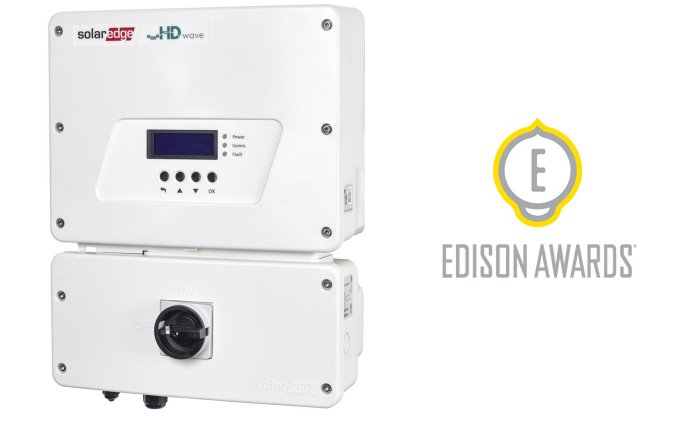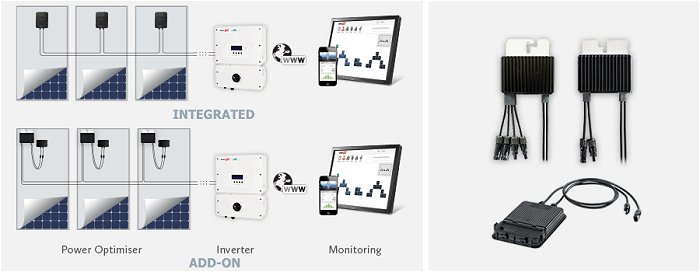SolarEdge was named the gold winner in the renewable energy category of this year’s Edison Awards for its HD-Wave inverter technology.
The Edison Awards have been run since 1987, recognizing (what it considers) the best in innovations and innovators.
SolarEdge said it was honored to have received the award.
“SolarEdge’s inverter with HD-Wave technology has already been recognized by the PV industry with awards for its innovation and potential to accelerate the proliferation of solar energy,” stated Guy Sella, CEO and Founder of SolarEdge.
The only other winner in the Edison Awards renewable energy category was Vestas for its V164 wind turbine, the world’s most powerful serially produced turbine. The latest model boasts 9.5MW capacity.
SolarEdge’s HD-Wave technology significantly reduces the size and weight of an inverter’s magnetics through advanced digital processing. The company says this technology increases reliability and optimises the performance of solar power systems to reach an inverter efficiency of 99%.
HD-Wave has been available in Australia since around the middle of last year. Check out Ronald’s review of SolarEdge HD-Wave technology.
HD-wave enabled inverters are designed for use with SolarEdge’s Power Optimizer product.
Like a micro-inverter, a Power Optimizer is added or integrated on the back of a solar panel1. If integrated at the point of panel manufacture, it replaces the conventional solar junction box.
While the device doesn’t convert DC to AC as in the case of a microinverter, it optimises energy output by continually tracking the maximum power point (MPPT) of each solar panel. The Power Optimizer also provides module-level monitoring and a safety feature whereby the panels’ DC voltage is shut down in the situation of an inverter or grid power failing. Optimizers enable flexible installation design with multiple orientations, tilts and panel types within the same string.
While it’s been relatively quiet with announcements, SolarEdge’s business appears to be doing well. In February, it released its fourth quarter and full year 2017 financial results; reporting total revenues of USD $607.0 million – up 24% from the prior year.
“We ended the fourth quarter and full year of 2017 with record results in our key financial and operational metrics,” said Mr. Sella.
Speaking of announcements or lack thereof, we haven’t heard any more on SolarEdge’s electric vehicle charger integrated inverter, which it showed off at Intersolar North America in July last year.
If you’re interested in what Australians who are using the company’s inverter products think of them, see our SolarEdge inverter reviews.
Footnotes
- microinverters aren’t always placed on the back of a panel, sometimes they are installed close to it ↩



 RSS - Posts
RSS - Posts



I have read, unfortunately, that the SolarEdge HD Wave Inverter does not allow for battery backup; if a SolarEdge HD Wave Inverter is installed, then, without replacing the inverter with an inverter that does allow for battery backup, once the SolarEdge HD Wave Inverter is installed, battery backup can not be installed.
This is unfortunate.
I also note that, whilst the Goodwe GW5048D-ES “UPS Multiple Mode Inverter – PV and Battery” inverter (the term apparently used by the CEC, to describe the type of inverter), has an “Automatic Switchover Time (for switching to battery backup power, when needed), of ” cycle time of 20ms), is sufficiently brief, to hide the outage, from (most?) electrical devices, therefore, making it “transparent”.
So, it appears that the SolarEdge HD Wave Inverter is ideal for multi-facted roofed premises, that have single phase electricity grid connection, as long as battery backup is not wanted, now or in the future.
I am not sure you are correct. I have that inverter with powerwall 2 and I have battery backup on one of my 3 phases. .
Unfortunately, the blog software threw out most of my post, wasting the time and effort that I put into the post.
Because the blog software completely corrupted my previous post that I had attempted to submit, and, misrepresented what I had submitted, I am trying to write and submit a new version of the post.
It appears that the defective blog software goes rabid with standard ASCII characters that are not aplhanumeric characters or commas or dots that are known as full stops, so I am trying to write this post without any characters that are not alphanumeric or commas or dots.
The SolarEdge HD Wave Inverter, from what I have read, is incompatible with, and, does not allow, storage battery backup.
The two main hybrid inverters that provide for storage battery backup, with a 5kW throughput capacity, for a single phase connection, appear to be the Goodwe GW5048D ES and the SolarEdge StorEdge SE5000AUS.
I note and I emphasise, that this relates to single phase electricity grid connections.
The Goodwe one apparently has an Automatic Switchover Time of less than 10ms.
The StorEdge one has a published Automatic Switchover Time of about 2s.
The StorEdge one, like the SolarEdge HD Wave Inverter, has the advantage of being suited to multifaceted roofed houses, like our house.
A representative of a local PV systems installer advised me that a manager of SolarEdge had told him that the Automatic Switchover Time of the StorEdge inverter, is in the milliseconds. However, SolarEdge is not willing to put that in writing, and it differs from the published specifications of the inverter, and, SolarEdge appear to be unwilling to acknowledge written correspondence querying the Austomatic Switchover Time of the StorEdge Inverter.
Goodwe, however, are willing to put in writing, that the Automatic Switchover Time of their inverter, is less than 10ms, and, to provide other technical information about their products.
That also, is a fundamental difference between Goodwe and SolarEdge, in that, whilst Goodwe are willing to put performance claims in writing, and, discuss technical details with prospective customers, SolarEdge are not.
Whilst people, including the representative of the local PV systems installer, may regard an Automatic Switchover Time in whole seconds, as being extremely good, and, adequate, a two second interval without electricity, is long enough to make electrical devices aware that they have no electricity, thence causing problems, including the notorious NBN devices, which are a root of great evil, and, they cause snowballing flow on problems.
We have had frequent flutters of electrcity supply, with the electricity going off for a couple or a few seconds at a time, and, the effects of those flutters. A couple of weeks ago, we had two such flutters, about half an hour apart, between 0000 and 0100.
From my understanding and perception, an Automatic Switchover Time of less than 10ms is sufficiently brief for the break in supply to be too short for electrical devies to be aware of it, as it is less than an AC power supply cycle, as, at 50Hz, a cycle has a period of 20ms, which is twice the period of the Automatic Switchover Time of the Goodwe GW5048D ES inverter.
So, in the context of the above report, it appears to me that the SolarEdge HD Wave Inverter is okay as a simple inverter, in that, for a multifacted building roof, such as we have on our house, it is ideal, and, can obtain the optimal electricity generation, but, it is limited in that it is only useful, as long as storage battery backup is not wanted, now, or ever, during the life of the inverter.
So, regardless of what awards the SolarEdge HD Wave Inverter has won, it is limited in its application, to scenarioes involving a stable and reliable grid electricity supply. And, we do not have that in the remote outpost known as the Perth metropolitan area of Western Australia.
Good info there Brett. Our suppliers have different knowledge. As per my previous post I had the SolarEdge HD Wave installed with battery backup and within days we had a grid outage and the backup kicked in. I cannot be certain how many miliseconds it took itit appeared to be very quick.
Further info. I have 6.4 on the roof. Powerwall 2. The SolarEdge is the JD Wave 5000. The backup mechanism is in a different box adjacent to meters. I don’t pretend to know the tech details but I certainly have battery backup that works.
Bill .
I have looked for the source of my information regarding the HD Wave inverter and backup, and, I found this;
at
http colon slash slash solar4ever dot com dot au slash SolarEdgeInverterReview dot php
is
Rule 2
If you want an emergency circuit to partly power your home from batteries during a mains power failure, then you MUST buy the StorEdge model. The HD-Wave does NOT have backup.
and, to confuse things, SolarEdge produce the
SolarEdge Single Phase HD Wave Inverter SE5000H
and the
StorEdge TM AC Coupled Single Phase Inverter with HD-Wave Technology for Australia SE5000H
with the former being for connection to PV panels and not a battery, and the latter being for connection to a battery, and not to PV panels.
And, for the latter, is
All the benefits of the HD-Wave technology record-breaking efficiency, extremely small,
lightweight and easy to install, and high reliability without any electrolytic capacitors
Specially designed to work side by side with three-phase SolarEdge inverters and non-
SolarEdge inverters
Compatible with the StorEdge Interfaces and selected battery vendors such as the LG Chem RESU
Monitors battery status, PV inverter production, and self-consumption data for full visibility
IP65 – Outdoor and indoor installation
No high voltage or current during installation, maintenance or firefighting for maximum safety
The StorEdge TM AC Coupled Inverter does not work with power optimisers or as a standard solar PV inverter
so it is a single phase inverter, for use only with three phase systems.
It gets confusinger and confusinger.
Bill, in case it is not clear in what I have posted above, your electricity system, you have said, is three phase, and, what I have posted, refers to single phase grid connections, apart from the inclusion of the reference to the single phase inverter that is exclusively for three phase grid connections.
I don’t pretend to understand most of your explanation. I can clarify that my house is three phase but my inverter and backup are only connected to one phase so for all purposes we should assume the house is single phase. I will post the model number of the inverter within 24 hours.
Ok. You commented earlier that SolarEdge SE5000H is for connecting PV but not batteries. Mine is that model and is working perfectly with Powerwall 2. All connected to one of my three phases.
It was installed by a major installer of these systems on East coast.